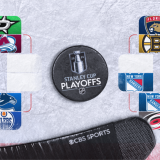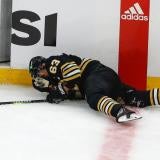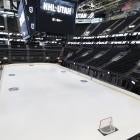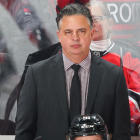The Columbus Blue Jackets were the first NHL team to fire their coach during the 2015-16 season when they replaced Todd Richards with John Tortorella following the team’s historically bad 0-7 start. In the immediate aftermath of that move there were a pair of simple, yet stunningly accurate quotes from Richards and the man perhaps most responsible for the team’s slow start, goaltender Sergei Bobrovsky (both quotes via Aaron Portzline of the Columbus-Dispatch).
First, there was Richards talking about his decision to continue running Bobrovsky out on the ice even as he struggled with his play and his confidence over the first two weeks of the season.
“I’ve said it before that he has made me a good coach through his goaltending,” Richards said. “He was my guy. If you’re going to go down, you go down with your guy.”
And then Bobrovsky…
“He’s a good coach, a good man,” Bobrovsky said. “It’s definitely a tough feeling right now. I didn’t play well for him this season. I feel responsibility for (his firing), of course.”
Both men, Richards with his quote about Bobrovsky making him a good coach through his goaltending, and Bobrovsky feeling responsibility for the firing, nailed it with their comments.
When a team decides to make an in-season coaching change it usually comes down to one of two things. The first is a poorly constructed team that a general manager thought was going to be better than it was. At that point he can’t replace all 23 guys on the roster, so he makes a coaching change and hopes a new voice and a new direction can lead to new and better results on the ice.
The second, and perhaps the most common denominator in just about every in-season coaching change over the years, is goaltending.
Specifically, bad goaltending. In a lot of cases, really, really, really bad goaltending.
Sometimes a team really does reach its limit with a coach and a change needs to be made. Two of the best examples are with Michel Therrien in Pittsburgh in 2008-09 and Terry Murray in Los Angeles early in the 2011-12 season. Those were changes that were needed and ended up working out perfectly with each team winning the Stanley Cup. But it very, very rarely works out that way for a team. It’s usually a problem that either extends above the coach, or is the result of a goalie that can’t keep the puck out of the net (or both).
Sometimes normally reliable goalies simply hits a rut and it brings down everything around them. If there is a team in the NHL that should know what that is all about this season, it’s Columbus.
Now, make no mistake here: This team hasn’t been good. And there was probably going to come a time when a coaching change was going to be necessary (it always reaches that point). But this team is not 0-7 bad. Almost nobody in the history of the league has been 0-7 bad. The single biggest reason they are is the fact their $8.5 million starting goalie -- and normally a damn good goalie -- played one of the worst stretches of his career at the start of a season where expectations for the team were at an all-time high. That is a brutal combination for a coach.

Through the first two weeks of the season Bobrovsky has been the worst goalie in hockey by a mile with an .835 save percentage. How much has that impacted the Blue Jackets’ success on the ice? Just consider that if he had faced the same number of shots (139) over his first five starts and stopped shots at a league average (.917 so far this season) rate, or at the same level he has played at since arriving in Columbus (.920), the Blue Jackets would have allowed 11 to 12 fewer goals in Bobrovsky’s five starts. That would be massive. That would easily be a couple of wins in the standings right now, and we probably wouldn’t be talking about a coaching change in Columbus at the moment.
The Blue Jackets are a team that has some warts. Their defense is not particularly strong, and it hasn’t played well this season. But no amount of breakdowns and no system should result in a goalie only stopping 83 percent of the shots he faces. Every goalie is going to face scoring chances. Every goalie is going to experience defensive breakdowns in front of them. When a goalie performance is that bad, it’s on them. And when you watch all of the goals that Bobrovsky has given up so far, it’s easy to see that for as much as the defense has struggled at times, he's let in some real stinkers.
There is going to come a point this season, and probably soon, when Bobrovsky is going to figure it out. He is going to return to the level he has shown that he is capable of playing at over the past few years. He will stop shots at an above average rate and the Blue Jackets will start winning games and the new coach will reap the benefits of that, not only in the standings, but when it comes to getting credit for fixing the team.
When you look back at teams that have made in-season coaching changes, and the way the coaching position is evaluated around the league, it’s easy to see just how much it’s connected to the performance of a team’s goaltending. Including Richards on Wednesday, there have been 33 in-season coaching changes in the NHL since the start of the 2007-08 season. Out of that group, 28 of those teams were receiving below average play from their goaltenders at the time of the change. Twenty-two of them had save percentages that were .903 or worse. Fifteen of them were below .900.
Here is what it looks like visually.

Again, it was probably time for some of these teams to part ways with their coach. I'm not trying to remove all blame from coaches. But there are also a lot of really good ones on that list that may have been prematurely fired for no other reason than their goaltending stunk early in a season.
Peter Laviolette is a heck of a hockey coach and has had success everywhere he's been. He is on that chart twice. Guy Boucher is probably the best head coaching candidate available and probably should still be in the NHL. He is on there. Ken Hitchcock is on there. There are five coaches (including Hitchcock) on there that have won the Jack Adams Award. And speaking of the Jack Adams Award, have a look at the kind of goaltending the past 20 winners of that award have received compared to the league average. The counter argument here is that maybe those coaches play a system that allows their team to boost their team's save percentage. But if that's the case, why were most of them not able to repeat it in the years that followed? Several of them were fired within two years of being voted the coach of the year.
Sometimes, no matter how good of a coach you are, you just can't overcome bad goaltending.
I keep going back to last year's Minnesota Wild and the impact a goalie has not only on the success of a team, but the reputation of a coach. A couple of months into the season they were at the bottom of the NHL standings, even though they had a talented, expensive roster that should have been better. It was obviously to anybody watching the team that goaltending was crushing their season. When they hit rock bottom in early January with a 7-2 loss in Pittsburgh, they kept their locker room closed for 30 minutes after the game and it seemed as if coach Mike Yeo already had both feet out the door. His firing seemed to be imminent. But instead of firing the coach, they fixed their goaltending situation. Coincidentally, It was at that point that Mike Yeo became a good coach again, the team started winning again (they won 28 of their final 40 regular season games) and not only rallied to make the playoffs, but also won a series and advanced to the second round.
I think the big takeaway here is that we really don't know how to evaluate coaches or what makes them succeed or fail, and goaltending is a big reason for that. It masks a lot of flaws when it's great, and it creates a lot of flaws that might not exist when it's bad.





















